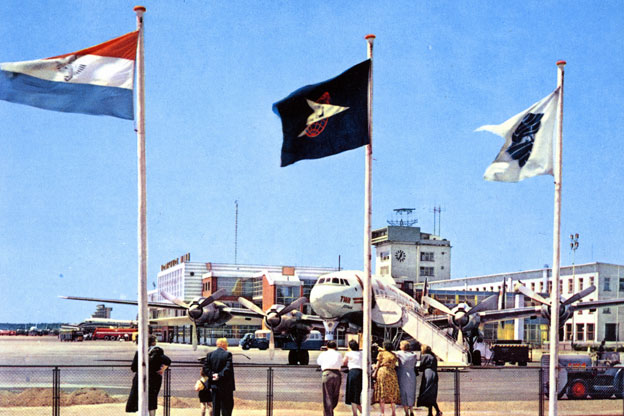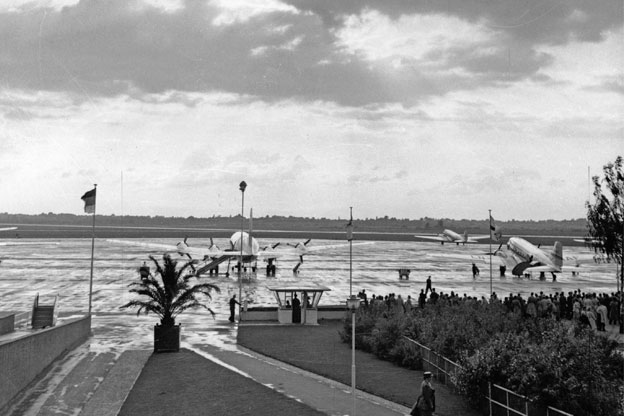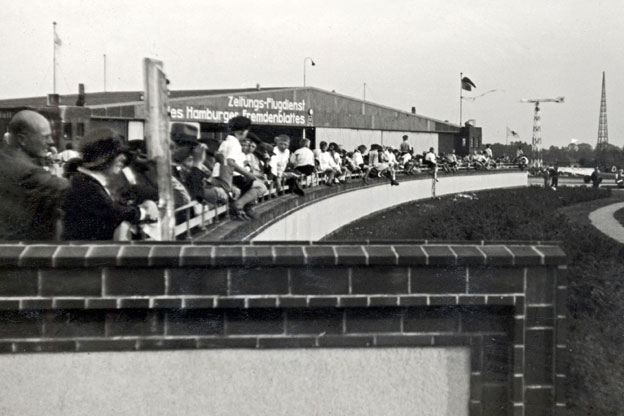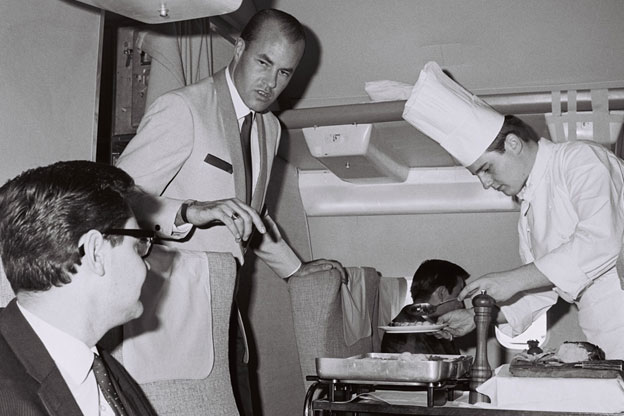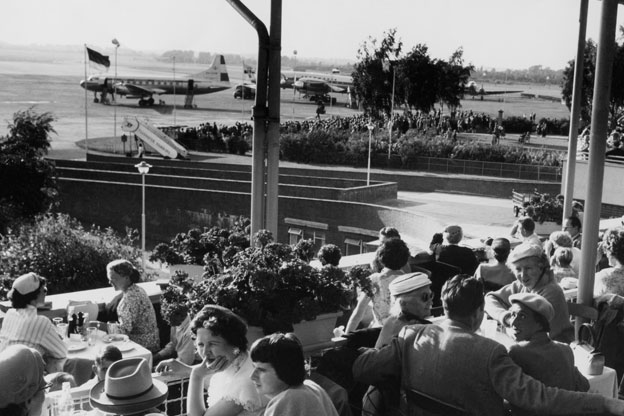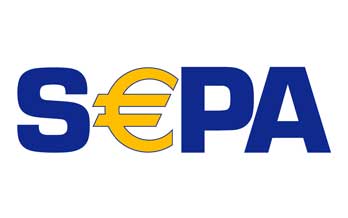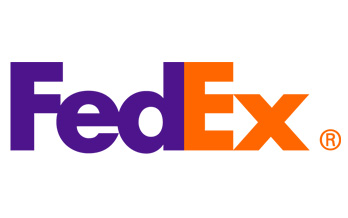
On a knife´s edge
When flying was more relaxed
“Once upon a time” – this is how fairy tales usually begin. But that’s precisely how this story could have begun, which from today’s perspective seems like something from a different world of air travel.
This story recalls a time when there were no security checks on passengers at airports, and when the aprons of airports were separated from the visitors’ terraces only by low fences. Like the passengers, the personnel walked onto the apron without being checked and could board the planes without being bothered. And there, on board the propeller planes and the first jets of the “Golden Age of Aviation”, objects were being carried that would make the hair of today’s security experts stand on end.
If you look at drawings of airports from the 1950s and 1960s, which show the paths taken by passengers from check-in to departure, you will notice that one detail is missing: the security check. Airplane hijackings were still very rare in those decades, and there were just five noteworthy incidents worldwide in the 1950s. In most cases, these “hijackings” were mostly harmless, and a different destination was all that was being demanded.
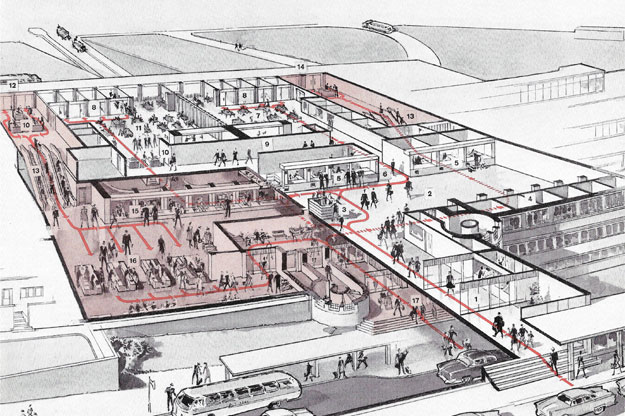
This schematic representation of Hamburg Airport’s original passenger terminal from the 1950s shows that one detail that dominates today was completely missing: the security checkpoint. Passengers could board the planes unmolested by security checks. Photo: Hamburg Airport
Hijackings from European countries of the then Eastern Bloc to the supposedly “golden” West or a flight to Cuba – to support Fidel Castro’s government out of political conviction – were “popular” at the time. Passengers and crews, on the other hand, mostly got off lightly. The few cases in which the plane crashed as a result of a hijacking or individuals on board were killed were negligible worldwide until the 1970s. And thus, the risk of hijacking was initially swept under
the carpet by the airlines and authorities, who preferred not to carry out checks so as not to unsettle passengers. The global security situation only deteriorated significantly with the burgeoning conflicts in the Middle East and the associated bomb attacks and bloody hijackings of commercial aircraft. Examples include the drama involving Lufthansa Boeing 737 “Landshut” in 1977 through to the world-changing events of September 11, 2001.
Smoking utensils for advertising purposes
This was largely the security situation when air travel took off to new heights in post-war times after 1945. Service was a top priority for the airlines in order to win the favor of air travelers. And therefore, they offered everything that was coveted by the mostly male air travelers of the time. These included lighters and pocket knives. While smoking is largely frowned upon today for health reasons, it was considered an expression of cosmopolitanism and joie de vivre,
particularly in the 1950s. This positive image of tobacco, especially in West Germany, also dated back to the immediate post-war years between 1945 and 1948, when cigarettes were exchanged for food on the black market, thus providing a substitute currency until the introduction of the deutschmark. One cigarette was roughly equivalent to 30 euros today, and was thus a valuable barter item.
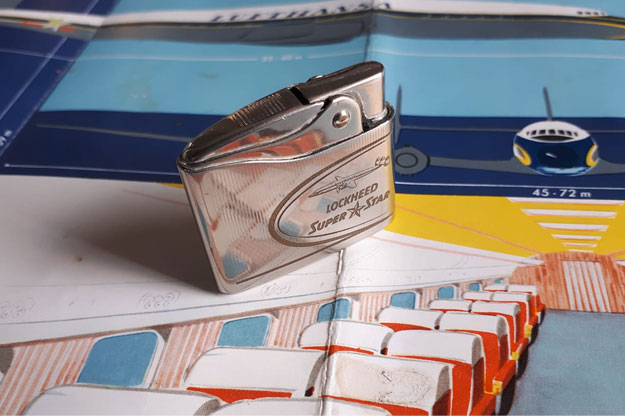
Lighters were distributed during the flight on board Lufthansa long-haul aircraft in the 1950s. Today, this would be strictly forbidden! Photo: Wolfgang Borgmann
It was not until the mid-1960s that the first reports on the health hazards of smoking were released in the media. The lifestyle aspect of cigarette consumption, which was seen as a sign of emancipation, especially among women, slowly gave way to the realization that smoking can be fatal in many cases. But until then, airlines pampered their passengers with everything they needed to smoke on board. Matchbooks, lighter-fluid and gas lighters, cigars, cigarettes, and cigarillos were distributed by flight attendants
throughout the cabin, which filled with blue tobacco smoke even before takeoff. Open fires at seats or in the on-board toilets, highly flammable lighter fluid and gas in the hands of passengers – nowadays a nightmare for all those involved in air traffic, which would lead to an immediate safety landing of an aircraft. But back in the “Golden Age”, crews were relaxed and ensured that their entrusted guests could indulge in their vice up in the air, as if continuing their daily lives on the ground.
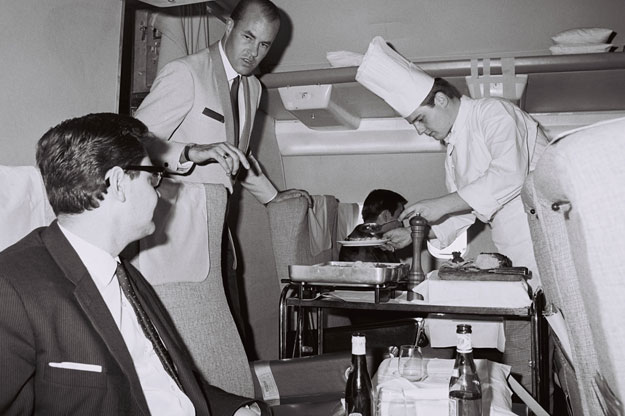
Roast preparation in a Lufthansa Boeing 707 galley. Of course, this was done with sharpened knives, which, had they fallen into the wrong hands, could have caused great mischief during the flight. Photo: Lufthansa
Especially since the distributed smoking paraphernalia served promotional purposes for the airlines. Just about every airline had lighters printed with their logos and distributed to their customers during the flight or in airline city offices. Particularly nice examples are the Lufthansa lighters from the second half of the 1950s with the silhouettes and names of the Lockheed L-1049G “Super Constellation” and L-1649A “Super Star” long-haul aircraft engraved into the metal.
They were the first two flagships of the new airline called Lufthansa, founded in 1953 and launched in 1955. The Snip series of lighters was produced by the West German manufacturer Rowenta in the 1950s and 1960s and was used for advertising purposes, and not just by Lufthansa. Measuring 5.5 × 4.8 × 1.3 cm, they were easy to carry in jacket pockets without being too bulky, making them popular with smokers. The engraved Lockheed planes also made them much coveted collector’s items, then as now.
Masterpieces of the art of forging
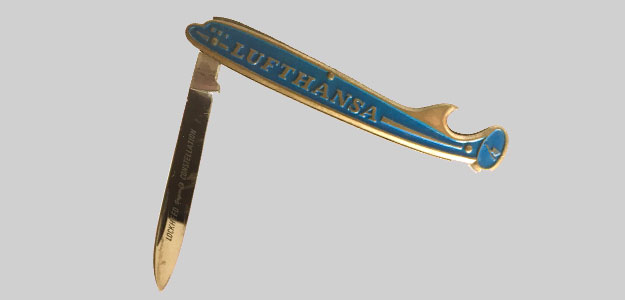
In the 1950s, airlines distributed in-flight souvenirs like this Lufthansa pocket knife in the shape of their Lockheed Super Constellation and Super Star long-haul aircraft. Nowadays, it would be a safety nightmare. Photo: Wolfgang Borgmann
Airlines also hoped for the everyday, peaceful experience of their passengers when it came to using the pocket knives they issued. With a blade length of six centimeters, which nowadays triggers a threat situation, they were merely much-admired masterpieces of blacksmithing almost seven decades ago. Airlines such as Lufthansa and the Scandinavian carrier SAS supplied these gems, which originated in the West German “blade town” of Solingen, the haft of which was molded in the shape of a Lockheed “Constellation” or Douglas DC-7C “Seven Seas”, distributed to their best customers and used on board without
restriction. There is no known case of these knives being used for anything other than their intended purpose, such as peeling fruit. This was also true of the personal knife sets of the cooks flying on board. One of their tasks was to portion roasts that had been precooked on the ground and reheated in the aircraft galley using long and extremely sharp carving knives. The knife sets required for this were their personal property and were carried from one flight to the next. As already described, there was no ban on any of these items, which are strictly forbidden from today’s point of view.
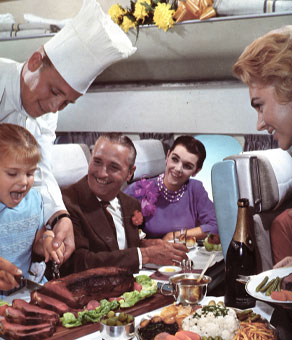
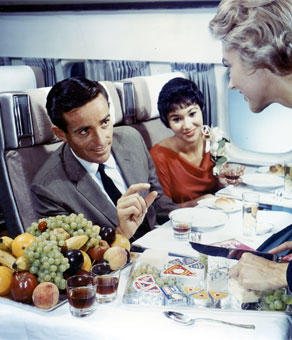
The extremely sharp kitchen knife seemed to separate a roast very easily, as served to First Class guests on board an SAS Douglas DC-8.
Some more cheese from the buffet cart, cut fresh from the wheel, of course. Photo: SAS Museet
And even if they had been, there would have been no one at the airports to remove them from use prior to departure. It wasn’t until the 1970s that passengers began to be patted down and while their carry-on luggage was being visually inspected before entering airport holding rooms, with police presence becoming increasingly obvious at airports.
It is sometimes good to remember more peaceful times when today’s passengers have to take off their shoes before the security check, are screened in the body scanner with their hands raised, and are only allowed to carry along the smallest volumes of liquid. Certainly not everything was better in the “good old days”, but often more peaceful, humane, and respectful in our interactions.
Report: Wolfgang Borgmann
Pictures: see sources for Pictures
Numbers, data, facts
In the 1960s, it was part of first-class service on board the Lufthansa Boeing 707 to carve the roast offered in front of the “Senator” passengers with extremely sharp knives.

